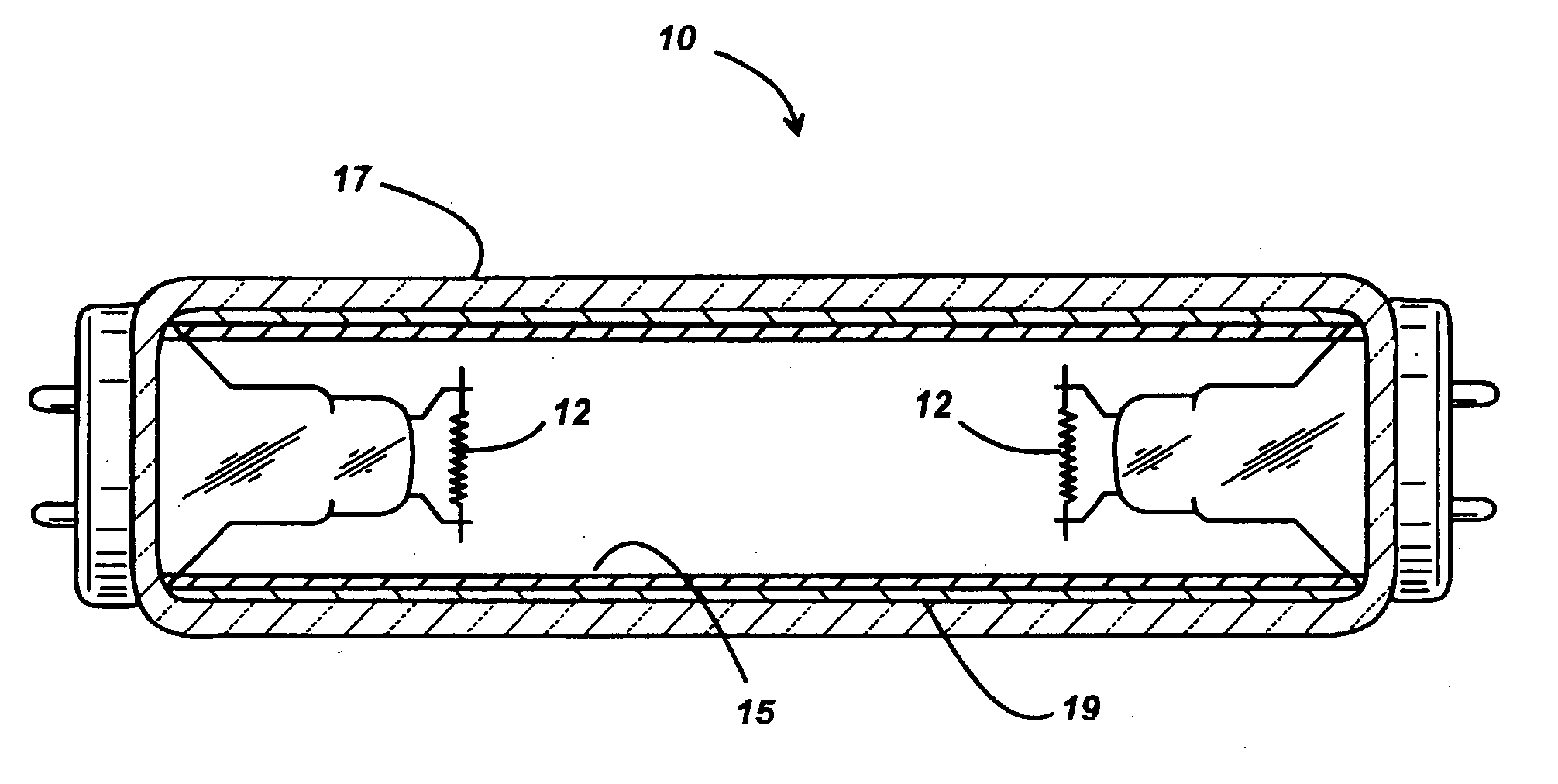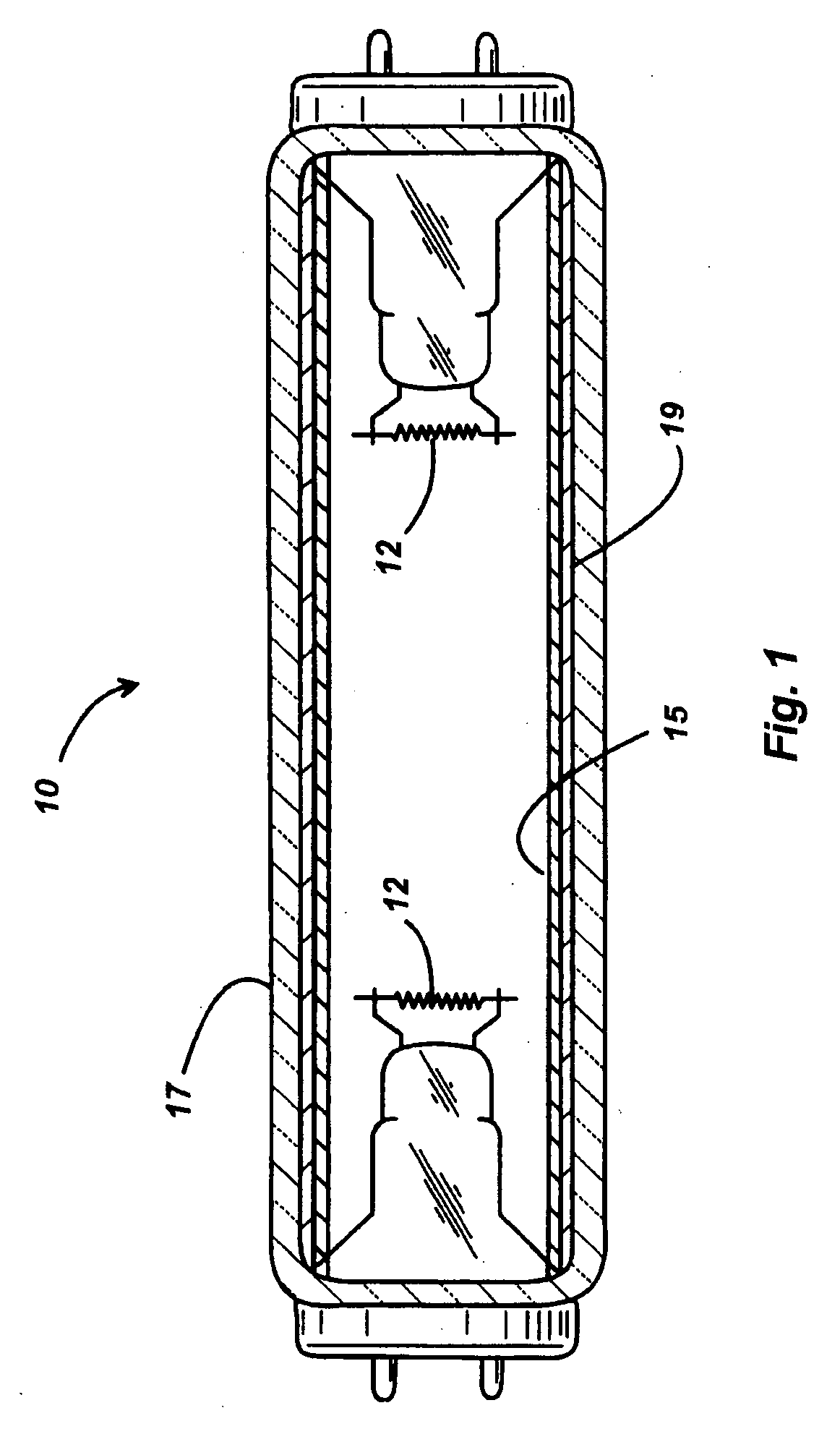UV-emitting phosphors, phosphor blend and lamp containing same
a technology of phosphor blend and fluorescent lamp, which is applied in the direction of discharge tube/lamp details, discharge tube luminescnet screen, low-pressure discharge lamp, etc., can solve the problems of poor maintenance of uv output in fluorescent lamps, cvd method requires relatively complex coating equipment and hazardous chemicals, and the activator itself, so as to improve the stabilization time of lamps.
- Summary
- Abstract
- Description
- Claims
- Application Information
AI Technical Summary
Benefits of technology
Problems solved by technology
Method used
Image
Examples
example 1
[0027] Reflector lamps were made with two phosphor coatings: (1) 100% YPO4:Ce (OSRAM SYLVANIA type 2040) and (2) a blend of 96 wt. % YPO4:Ce and 4 wt. % (Mg,Sr)Al11O19:Ce (OSRAM SYLVANIA type 2096). Two reflector coatings were also evaluated: (1) 100% HPA and (2) a mixture of 75:25 by weight HPA / CR30. HPA is an alpha alumina powder made by Baikowski and has a surface area of about 5 m2 / g. CR30 is a another commercially available alumina from Baikowski and has a surface area of about 30 m2 / g.
[0028] The coated lamps were finished (i.e. made into working lamps) together with state-of-the-art tanning lamps as a control (See, e.g., U.S. Pat. No. 6,984,931) using the same fill gas composition and fill pressure.
[0029] The SPD of the 96:4 2040 / 2096 test group, curve marked DLF78, with 75:25 HPA / CR30 reflector alumina is shown in FIG. 3. By comparing normalized lamp SPDs, it can be seen that the test group has a very different SPD than both the standard lamp using 100% BaSi2O5:Pb phosphor ...
example 2
[0035] Reflector lamps were coated with a new phosphor blend as shown in Table 2. In this case, the blend used was 96:4 by weight of YPO4:Ce / LaPO4:Ce. The LaPO4:Ce phosphor (OSRAM SYLVANIA Type 2080) has a different intrinsic emission spectrum compared to type 2096 phosphor that was used in Example 1.
[0036] The UV reflector material was also different than Example 1. In these lamps, the reflector layer was 100% CR6 alumina which is an alpha alumina manufactured by Baikowski with surface area of about 6 m2 / g. It was found that the CR6 alumina had a higher reflectance in the UVA and UVB region of the electromagnetic spectrum compared to the HPA alumina. In particular, glass slides were coated with both HPA alumina and CR6 alumina at various levels of powder loading and measured for UV reflectance. The CR6 alumina was found to exceed HPA alumina in UV reflectance at all wavelengths between 300 to 400 nm which is the region of interest for UV emitting tanning lamps. Based on this, it w...
PUM
 Login to View More
Login to View More Abstract
Description
Claims
Application Information
 Login to View More
Login to View More - R&D
- Intellectual Property
- Life Sciences
- Materials
- Tech Scout
- Unparalleled Data Quality
- Higher Quality Content
- 60% Fewer Hallucinations
Browse by: Latest US Patents, China's latest patents, Technical Efficacy Thesaurus, Application Domain, Technology Topic, Popular Technical Reports.
© 2025 PatSnap. All rights reserved.Legal|Privacy policy|Modern Slavery Act Transparency Statement|Sitemap|About US| Contact US: help@patsnap.com



